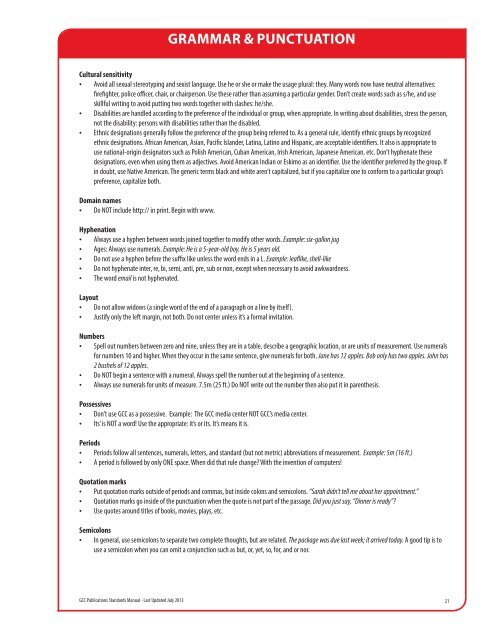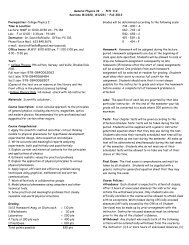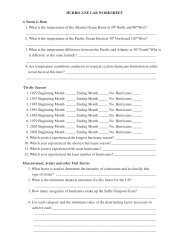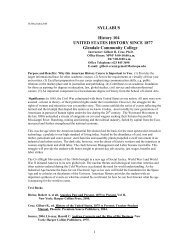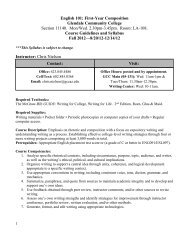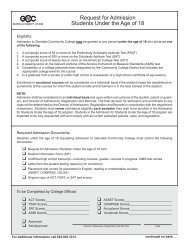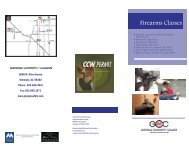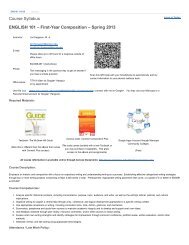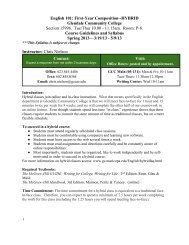Publications Standards Manual - glendale community college
Publications Standards Manual - glendale community college
Publications Standards Manual - glendale community college
You also want an ePaper? Increase the reach of your titles
YUMPU automatically turns print PDFs into web optimized ePapers that Google loves.
Grammar & PUNCTUATION<br />
Cultural sensitivity<br />
• Avoid all sexual stereotyping and sexist language. Use he or she or make the usage plural: they. Many words now have neutral alternatives:<br />
firefighter, police officer, chair, or chairperson. Use these rather than assuming a particular gender. Don’t create words such as s/he, and use<br />
skillful writing to avoid putting two words together with slashes: he/she.<br />
• Disabilities are handled according to the preference of the individual or group, when appropriate. In writing about disabilities, stress the person,<br />
not the disability: persons with disabilities rather than the disabled.<br />
• Ethnic designations generally follow the preference of the group being referred to. As a general rule, identify ethnic groups by recognized<br />
ethnic designations. African American, Asian, Pacific Islander, Latina, Latino and Hispanic, are acceptable identifiers. It also is appropriate to<br />
use national-origin designators such as Polish American, Cuban American, Irish American, Japanese American, etc. Don’t hyphenate these<br />
designations, even when using them as adjectives. Avoid American Indian or Eskimo as an identifier. Use the identifier preferred by the group. If<br />
in doubt, use Native American. The generic terms black and white aren’t capitalized, but if you capitalize one to conform to a particular group’s<br />
preference, capitalize both.<br />
Domain names<br />
• Do NOT include http:// in print. Begin with www.<br />
Hyphenation<br />
• Always use a hyphen between words joined together to modify other words. Example: six-gallon jug<br />
• Ages: Always use numerals. Example: He is a 5-year-old boy. He is 5 years old.<br />
• Do not use a hyphen before the suffix like unless the word ends in a L. Example: leaflike, shell-like<br />
• Do not hyphenate inter, re, bi, semi, anti, pre, sub or non, except when necessary to avoid awkwardness.<br />
• The word email is not hyphenated.<br />
Layout<br />
• Do not allow widows (a single word of the end of a paragraph on a line by itself).<br />
• Justify only the left margin, not both. Do not center unless it’s a formal invitation.<br />
Numbers<br />
• Spell out numbers between zero and nine, unless they are in a table, describe a geographic location, or are units of measurement. Use numerals<br />
for numbers 10 and higher. When they occur in the same sentence, give numerals for both. Jane has 12 apples. Bob only has two apples. John has<br />
2 bushels of 12 apples.<br />
• Do NOT begin a sentence with a numeral. Always spell the number out at the beginning of a sentence.<br />
• Always use numerals for units of measure. 7.5m (25 ft.) Do NOT write out the number then also put it in parenthesis.<br />
Possessives<br />
• Don’t use GCC as a possessive. Example: The GCC media center NOT GCC’s media center.<br />
• Its’ is NOT a word! Use the appropriate: it’s or its. It’s means it is.<br />
Periods<br />
• Periods follow all sentences, numerals, letters, and standard (but not metric) abbreviations of measurement. Example: 5m (16 ft.)<br />
• A period is followed by only ONE space. When did that rule change With the invention of computers!<br />
Quotation marks<br />
• Put quotation marks outside of periods and commas, but inside colons and semicolons. “Sarah didn’t tell me about her appointment.”<br />
• Quotation marks go inside of the punctuation when the quote is not part of the passage. Did you just say, “Dinner is ready”<br />
• Use quotes around titles of books, movies, plays, etc.<br />
Semicolons<br />
• In general, use semicolons to separate two complete thoughts, but are related. The package was due last week; it arrived today. A good tip is to<br />
use a semicolon when you can omit a conjunction such as but, or, yet, so, for, and or nor.<br />
GCC <strong>Publications</strong> <strong>Standards</strong> <strong>Manual</strong> - Last Updated July 2013 21


